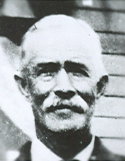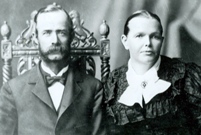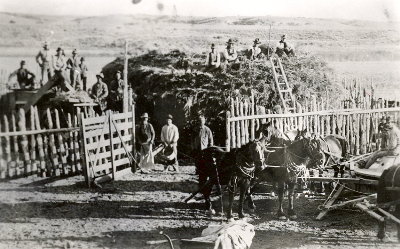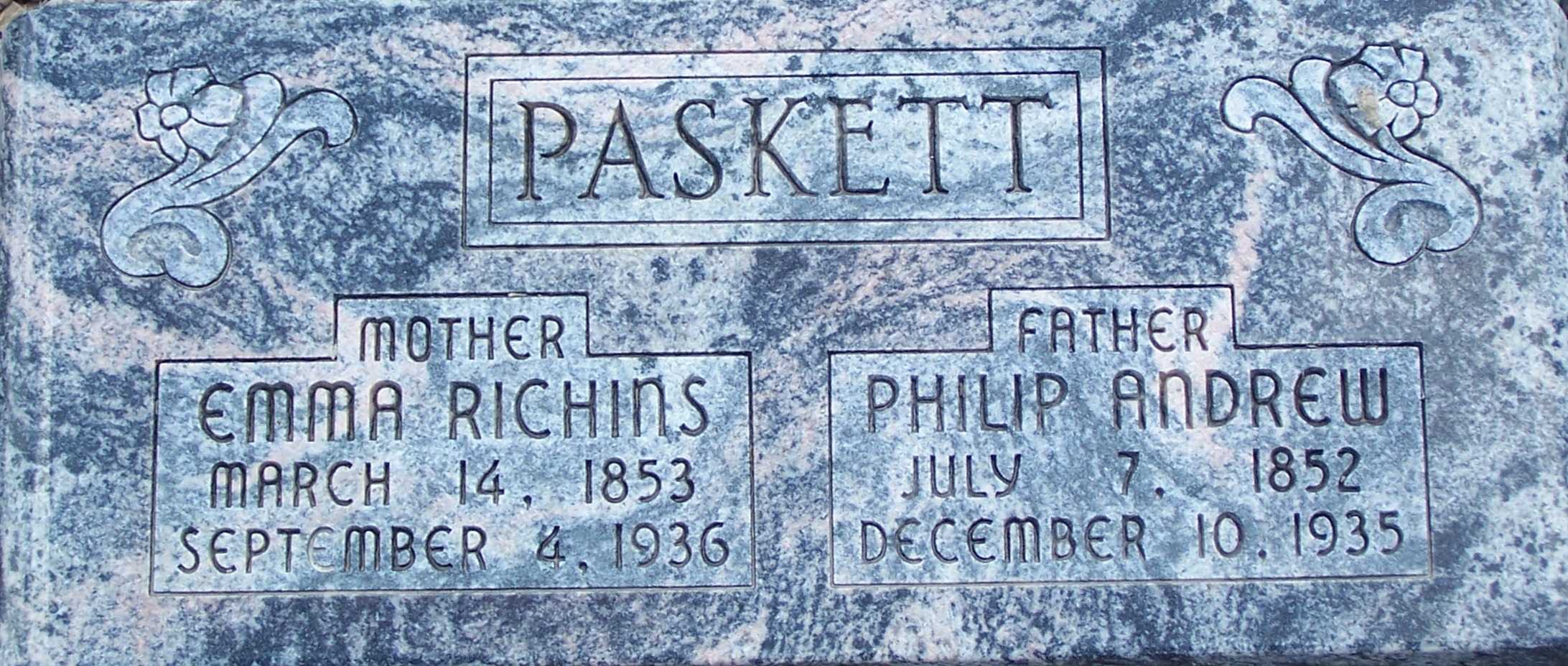 (Note: As he wrote, Philip would change from first person to third person and back again.)
(Note: As he wrote, Philip would change from first person to third person and back again.)
Philip Andrew Paskett, the subject and writer of this article, was the second son of James Pope Paskett and Charlotte Buckingham. I was born at Tetbury, Gloucestershire, England, on July 7, 1852. I attended school until I was about fourteen years old and then learned my father’s trade, which was shoemaking. After working several jobs, the way opened up for me to immigrate toUtah. My oldest sister, Sarah, and I sailed from Liverpool, England, on August 9, 1871. We were fourteen days on the ocean and seven days traveling by train. When we arrived at Echo Station,Utah, we were met by William C. Betteridge, a friend of my sister’s and my brother, John C. Paskett. They took us to Henefer to my sister, Fanny’s, who had come to Utah several years before. While there, I became engaged to a young woman named Emma Richins, and on June 16, 1873, we were married in the old Endowment House in Salt Lake City.
Early in the spring of 1877, we saw a letter in the Deseret News describing Grouse Creek Valley and after talking it over, decided to go and have a look. Those that went were William C. Betteridge, Albert F. Richins, Robert Allen Jones, William Richins and myself. After arriving, we met William Gallaher, Richard Warburton and Valison Tanner. They told us the West Fork was taken up but there was good land on the East Fork. We staked off the land on the East Fork, built a one-room cabin and decided to let A.F. Richins and Allen Jones go back to Henefer and bring their families, so as to hold the land. After arriving home, Allen Jones concluded not to move to Grouse Creek, so James R. Simpson and family came to Grouse Creek with A.F. Richins instead, both families moving in one covered wagon with one yoke of oxen as team. They arrived in June. William C. Betteridge and P. Paskett went to Henefer for their families and moved down in the following October. Also, William P. Paskett and family. Brother James Simpson was a good stone mason and was a great help in building. We lived in our covered wagons the first winter.

Philip & Emma Richins Paskett
On July 17, 1879, we were visited by Box Elder Stake Authorities and were organized into a Ward. Samuel H. Kimball was chosen and sustained as Bishop, Benjamin F. Cooke and Philip A. Paskett as counselors. In about a year and a half Bishop Kimball resigned, and Charles Kimber Sr. was chosen and sustained as Bishop. He chose Philip A. Paskett and William P. Paskett as counselors. I find this took place on September 15, 1882.
In the spring of 1882 the whooping cough was very prevalent in Cooksville and Grouse Creek. It was bad in the following families: David H. Toyn’s, Jesse Morgan’s, Albert F. Richins’s, Marshall Grover’s, William P. Paskett’s, William C. Betteridge’s, James R. Simpson’s, Rachel Lee’s, and Thomas Davis’. The Elders were often called on to administer to the sick and not one case proved fatal.
In Cooksville on December 11, 1882 a meeting was held at the house of Marshall Grover for the purpose of attending to school business. D.H. Toyn stated the object of the meeting was to start a school immediately. It was agreed that I be hired as teacher for $35.00 per month. I was released from acting as Trustee on account of my being appointed teacher.
P. Paskett started school on December 19, 1882, with twenty-five scholars. There names were: Mary Toyn, Alice Kimber, Ida Grover, Fannie Kimber, Emily Paskett, Eliza Richins, Charlotte Paskett, Maud Davis, Francis Toyn, Sarah Paskett, Edwin Shaw, James T. Shaw, James Betteridge, John Betteridge, John Haynes, Thomas Haynes, Henry Lee, Eli Lee, Isaac Lee, Alva Lee, David A. Toyn, Robert Grover, Samuel Grover, George Richins, and James Simpson.
On December 3, 1886, I and my family moved down on the new town site near Dry Hollow, into a log house, being the first to build a house on the new town site.
In the fall of 1891, a very favorable account appeared in the papers about settling in Mexico, and Brother Charles Kimber Jr. proposed to me that we sell out and move down to Mexico. As I thought a change of climate, especially a warmer one, would be favorable to my rheumatism, I consented to do so. We traveled across the desert to Tooele, our boys driving the loose horses. We passed the Goshen and Sanpete Counties, over the divide to Huntington, and there we met a number of people who returned from Arizona and gave an unfavorable account of the south country. So we wintered in Huntington, Emery County and in June I decided to move north again, up into Snake River Valley where many settlers were going. Charles Kimber moved back to Grouse Creek and predicted that I would soon land there. After a time in Idaho my rheumatism got so bad that I was bedridden. I wrote to my wife’s brother, Albert F. Richins, asking him if he could send a team from Grouse Creek and help us back. He readily responded and hired Johnny Haynes to bring a team to Riverside to help me and my family. Hyrum Crofts who had married my daughter, Lottie, brought his team and wagon from Basalt to help us. I gave him two cows. A bed was placed in one wagon to lay me on. It took seven days and a half to reach Grouse Creek. During all this time I was unable to turn over in bed.

Thrashing Machine: George Paskett, Willington Richins, Newell Richins, Moroni Tanner, Uknown, Uknown, Orson Richins – Haystack: Unknown, Ralph Tanner, Valison Tanner Jr., Uknown, Sidney Paskett – Ground: Lorenzo Richins, Wilford Richins, Albert F. Richins and Phillip Paskett
My wife was very kind and attentive to me and waited on me hand and foot. She never complained. I obtained a rock house belonging to my wife’s brother, Lorenzo, to live in. After suffering intensely for about three months, Bishop Goodliffe of Snowville came in, stood by my bed, looked at me and pronounced a blessing of health upon me. From this time, the pain left and I got better. We afterwards took up eight acres of land at the south of Dry Hollow. My wife entered it under the Desert Act.
The people were very kind to us, especially Uncle Albert F. Richins. One evening he and another man walked into the house carrying a big fat pig between them, killed, dressed, and ready to cut up. I looked at it in amazement and asked him what it would cost me. He said, “Nothing, you are welcome to it.” I thanked him for it. He let me have anything we wanted from his store.
We bought eighty acres of land from the State at the mouth of Dry Hollow. We built a two-room log house (one room at a time), a corral, etc. We got the logs up Red Butte canyon. My son, Philip J., was a big boy by this time and worked hard to get us fixed up. In May 1895 our last child, Christine, was born, which made us twelve in all – six sons and six daughters. All that were old enough to work, helped out the best they could. I felt very thankful for being able to work again. We cleared the land, fenced the field and raised some crops.
Several years after that, my brother-in-law, William C. Betteridge, bought the farm of Edward Kimber and John Haynes decided to sell his farm adjoining it. William told me if I wanted to buy his farm lower down the valley he would buy John Haynes out. I told him I did not have enough money to buy his. He said he had been talking to J.C. Lee at Tacoma, Nevada, and he would lend me the money if I wanted it. I borrowed the $1,200 necessary and bought the farm and a forty-acre water right. It was well fenced and most of it under cultivation.
I now felt that I was on the equal with the rest of the farmers. So, we have worked along doing the best we could, taking part in Church affairs and also regular affairs. We have been treated exceptionally well by our neighbors and especially Uncle Albert Richins.
We moved into our new five-room frame home on December 23, 1910 and very much appreciated a shingle roof and a new house.
I taught school the first two years at Grouse Creek and was trustee of the school until the Box Elder school district was formed. I have been water master for several years. I was elected Justice of the Peace and served as such for about twenty-four years with some little exceptions and also held the position of Notary and Registrar of Vital Statistics, (births and deaths) for about the same number of years.
On June 16, 1923, as it was just fifty years since my wife and I were married in the Endowment House in Salt Lake City, our boys and girls (some of them) made preparations to gather and celebrate our “Golden Wedding.” We met at our daughter Annie Barlow’s and partook of a fine dinner which had been prepared and was enjoyed much. After dinner Philip A. Paskett talked awhile to those present eulogizing the good qualities of his wife, their mother, and saying he could not remember the time that she ever gave him a scolding, not because he didn’t deserve it, but because she was submissive and good. He said his wife had been faithful and true, had been a good wife and mother. A good manager and had raised a large family under pioneer conditions. Some of our boys and girls could not attend because they did not get notice in time to be present.
Philip Andrew Paskett died on December 10, 1935. The funeral services were held on December 13, 1935 in the Grouse Creek ward meeting house, with Bishop John Hadfield officiating. Charles Toyn offered the invocation. Bishop Toyn spoke of his long association with the deceased. Heber Simpson was the principle speaker and said that Philip Paskett had carried on an honored name and for his posterity to do the same. He told of the blessings awaiting Philip, of his truth and intelligence. Remarks were given by Bishop John Hadfield. The closing prayer was given by Elmer Kimber. The grave was dedicated by Stephen Paskett. Many friends and relatives attended the services. Philip Paskett’s sister Jane, aged ninety-one, came all the way from Henefer, Utah. Interment was in the Grouse Creek cemetery.
Words written by Albert Sutton Paskett on December 18, 1935 said that my grandfather was one of those stalwarts who made the desert blossom “as a rose.” He has preached a great sermon every day of his life because it has been truly said the life of a good man is the greatest sermon that has ever been preached.
The last years of my grandfather’s life was a blessing to all of us. He was a scholar, a seeker of truth, a source of inspiration to his friends. During the last years of his life it was one of my greatest pleasures to sit and talk with him. He was an educated man. He loved to talk on the principles of the gospel. He was sound in doctrine, and understood much, a trait peculiar to seekers of truth.
Condensed by Sharon Kae Kimber for this edition.
This was taken from his life history written by him.

